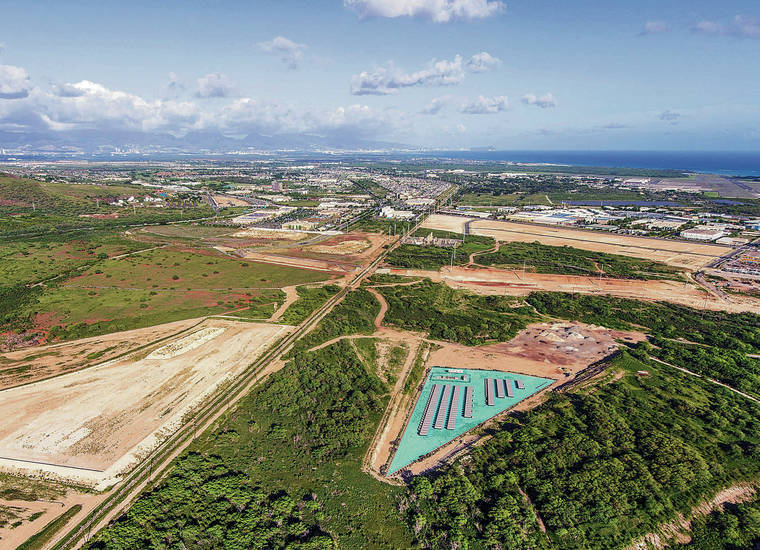Utility regulators in Hawaii backed off of several conditions they earlier had imposed on a $500 million energy storage project intended to help speed the retirement of a coal-fired power plant and advance the state’s clean energy goals.
Earlier in May, Hawaiian Electric asked regulators to remove operational and financial conditions imposed in its April 29 decision and order (No. 37754). The utility said that without changes to the order, it would have been “nearly impossible for the project to move forward.”
The proposed 185 MW/565 MWh battery energy storage system (BESS) on Oahu won approval from Hawaii state utility regulators, paving the way for Plus Power to begin construction.
The Kapolei Energy Storage project was selected a year ago as part of Hawaiian Electric’s transition away from fossil-fired generation. In all, 15 renewable energy and battery storage projects located across three islands were selected. Plus Power’s Kapolei project was the largest battery storage project in the group.
The lithium-ion battery project will be located on eight acres in an industrial area, where it will interconnect with a Hawaiian Electric substation. The project will provide load shifting and fast-frequency response services to Hawaiian Electric, enhancing grid reliability and accelerating the integration of renewable energy. The project is planned to enter service in June 2022 in advance of the closing three months later of the island’s last coal-fired power plant, which is owned by AES.
In early May, the utility asked regulators to modify or withdraw six of nine conditions that were placed on the project’s approval. The utility argued that without modification, the decision would send a “chilling message” to developers about the state’s renewable energy and storage markets.
In their modified decision, regulators said they had voiced concerns about the BESS on several occasions, particularly when it came to the utility’s plans to charge the battery with fossil-fueled generation in both the short- and long-term, as well as the utility’s ability to deliver benefits to its customers.
Serious situation developing
Regulators said that aside from citing the “urgent need” to replace the AES coal plant, “little was proffered in terms of the project’s customer benefits, ultimately compelling the Commission to impose several conditions in approving the project.”
Regulators acknowledged that they had used “pointed language” in describing what they said was their “disappointment” with having “few options to respond to the extremely serious situation that is developing” in terms of the coal plant’s looming retirement. They said it was “expressly the lack of other viable options” that contributed to the need for the BESS.
Even so, regulators said that concessions offered by the utility led them to revise parts of their earlier decision.
The commission modified its decision by removing threshold requirements and dates. Instead, it said it would conduct a prudence review of the storage system’s use and energy costs on an annual basis for the first 10 years of its operations.
Regulators also said that they would continue to require the retirement of Waiau Units 3 and 4 by 2024, noting that the date represented a “stated commitment” by the utility. However, the commission removed a requirement that the remaining units at the 500 MW, oil-fueled plant be retired by a specific date. Instead, those units would be prioritized as part of a retirement plan being developed in a separate docket.
Regulators also initially required Hawaiian Electric to file monthly reports on renewable energy utilization, a requirement that the utility said would be “duplicative and onerous.”
The utility indicated that while it was impossible to say how much of the energy stored in the BESS was generated by renewable resources, it could show what the resource mix was on the company’s system as the BESS was being charged. It said that data would be a proxy for the mix of energy that was being stored.
This content is protected by copyright and may not be reused. If you want to cooperate with us and would like to reuse some of our content, please contact: editors@pv-magazine.com.









By submitting this form you agree to pv magazine using your data for the purposes of publishing your comment.
Your personal data will only be disclosed or otherwise transmitted to third parties for the purposes of spam filtering or if this is necessary for technical maintenance of the website. Any other transfer to third parties will not take place unless this is justified on the basis of applicable data protection regulations or if pv magazine is legally obliged to do so.
You may revoke this consent at any time with effect for the future, in which case your personal data will be deleted immediately. Otherwise, your data will be deleted if pv magazine has processed your request or the purpose of data storage is fulfilled.
Further information on data privacy can be found in our Data Protection Policy.